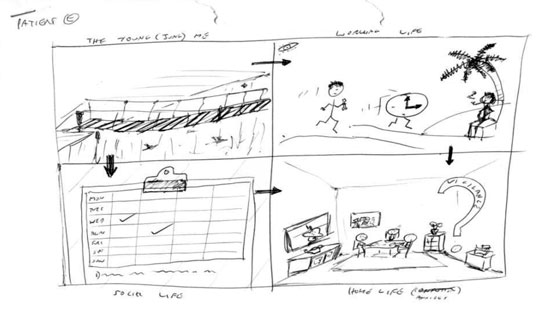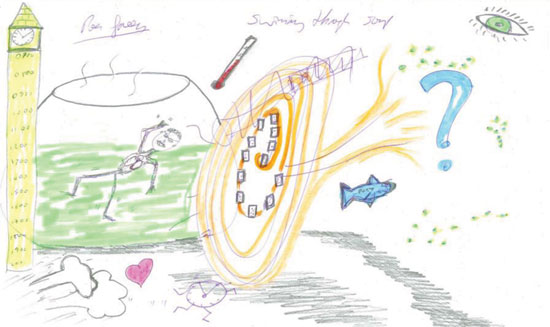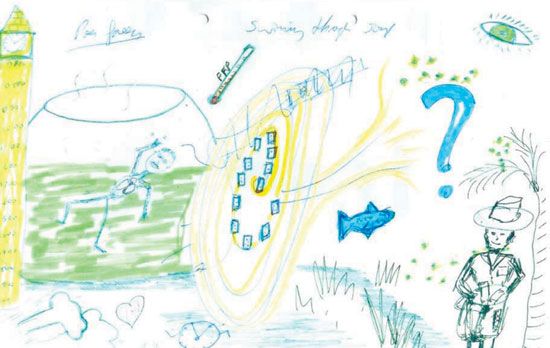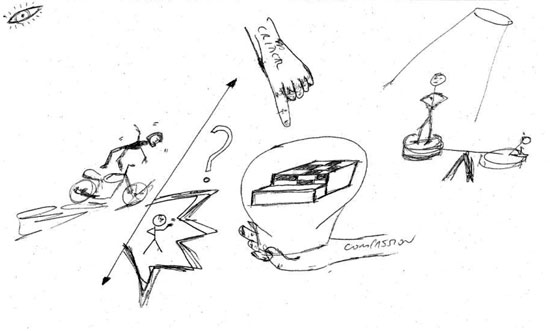CAT, Metaphor and Pictures
Turner, J., 2011. CAT, Metaphor and Pictures. Reformulation, Winter, pp.39-43.
An outline of the use of a pictorial metaphor in Cognitive Analytic Therapy
Abstract
This paper represents the second in a series exploring the use of metaphor and pictorial metaphor in Cognitive Analytic Therapy (CAT). Part one reported the findings from workshops at a variety of CAT conferences in 2009 and 2010; findings that indicated that metaphor was relatively well noticed in CAT but not always utilised. In this paper I shall explore the use of metaphor and pictorial metaphor in CAT using some case study material.
Introduction and background
Metaphors were out of my mind at one stage in my therapeutic career until one day I started to notice them more and appreciate the salience they had for understanding a client's mental state. When I began to notice them they seemed important, a central issue if you like, that could thread their way through the therapy sessions. Like the CAT model, they became a holding aspect of the therapy, enabling me to hold an issue and progress with a client. This focus first came about from developing a picture with a client, a sequence of metaphoric images that were mutually co-constructed in session with a client (Fig 1). I was struggling with him to make headway into recognition of his TPP's. We had a reformulation and an SDR but I was struggling to enable the client to access these in between sessions. During a session an image of how he described his early life came to me of 'the rickety bridge', then his work life as the 'chasing time' and then current life sitting at home looking out with cowboys (builders) outside that were creating him stress and tension and finally a sense of how he filled his time (he didn’t). It seemed that these images enabled an 'ah ha' moment for him and he became better able to appreciate and bring to mind his procedures and SDR.
Fig 1 - An early Pictorial metaphor

Since this client my practice has often been, when appropriate, to listen to the ‘metaphorical’ language the client uses and draw this into a ‘picture’. Usually this is following reformulation, typically sessions 7 to 8, as at this point we have already an image in the form of the SDR to work with and an understanding of the client through their reformulation. There are essentially two parts to this, the first being attune to the metaphors the client utters, the second making a deliberate step in a session to put pen to paper.
My experience of using pictorial metaphors in sessions seems to have provided me with another 'technique' when working with clients and helping them re-evaluate their circumstances. As we can do with other techniques, 'the empty chair', 'unsent letters', using parable, fable and cinema references for example, they all add to the richness of a therapy session. I guess where I am at the moment is understanding the process involved in working with metaphor and pictorial metaphor and trying to find out the significant steps that are important in utilising this technique. The assumption being that in doing so the client’s creative emotional processes can be drawn upon as well as their cognitions (Wilkinson 2010). Because it seems that the client is able to access a picture/image easily in his/her mind’s eye.
There is something here also about the roles of the left and right brain. McGilcrest (2009) notes ‘only the right hemisphere has the capacity to understand metaphor’ (p115). He outlines in some detail the workings of the mind that it may be the case that we ‘lean’ toward a certain hemisphere in working out issues. I confess to being left a bit overwhelmed by the volume of literature being developed in neuroscience at the moment. However, I am left with a belief that in engaging the right brain metaphorically to help a client understand and change an important step is being taken. Some clients, and indeed some therapists, lean towards one hemisphere or the other. What appears important is to recognise a person has logical objective and analytical as well as the metaphoric and that working with both can lead to growth and positive mental health (Welch 1984). CAT literature notices metaphor and in particular a striking example from Liz Wilde McCormick (2002) comes to mind…the client was:
‘either a battering ram or modelling clay…one week she spontaneously reached a middle position which married the positive value of each pole of her dilemma…like springy steel’ (ibid, p205).
This metaphor creates a rich insight into the client’s current state and experience. We hear the client’s story through dialogue consisting of and an exchange of signs; words, gestures or tokens (Stiles 1997).
With permission I want to now just take you through some of the steps and case material in developing the picture, as some of the main comments I have had in looking into this topic were regarding the ‘therapist leading the drawing’ and about confidence of the therapists artistic skill in taking the position of drawer. This is tricky because in actively working in this way one could be encouraging the client to enact a dance, ‘trying to please’ for example. I hope also you can see that you don’t need a lot of artistic skill to develop the rudimentary drawings of metaphors, and in fact I think, because the drawings are so sketchy, this helps the client to engage and modify them themselves. I recognise that this is difficult for some therapists who think they can't draw and perhaps may even have strong feelings about this. However, by way of reassurance in a couple of the workshops that ran last year most of the participants were able to put pen to paper to represent metaphoric images when given the time and support to do this.
I am indebted to the generosity of my clients who have agreed to let me use part of their work and who have taken the extra step of commenting specifically on this/their ‘pictorial metaphor’. Informed consent has been granted by each of the clients whose case material has been utilised in accordance with ACAT research governance procedures (ACAT 1995 & 2009).
Process
Kopp (1995, p5-12), in his well developed evaluation of metaphors in psychotherapy, notes a number of useful steps. I thought it would be useful to integrate Kopps’ steps and the way in which I have been working on developing the pictorial metaphor (my Italics):
Figure 2

Step 1: Notice metaphor – Listening out for metaphors becomes a habit after a while, I find myself either writing them down for discussion and clarification later or exploring them when they come up in session in the here and now.
Step 2a: Explore the metaphoric image When you say ... What image/picture comes to mind? What do you see in your mind’s eye? Could you describe? – These prompts work well, I tend to ask the client ‘what would this look like if it was a picture?'…sketch it out and show it back....does it look like this?
Step 2a: If client does not respond If I were seeing it (the metaphor) the way you see it what would I see? May I tell you what image occurs to me? – It is important to collaboratively create the picture, it may be that the client does not want to progress this metaphoric imagery further so be prepared to stop and go no further rather than impose. I guess you will have pictures in your mind’s eye, what is important is that they become a shared picture not one ‘foisted’ upon the client.
Step 3: Exploration of the metaphor as sensory image What else can you see? Describe the scene What else is going on? What are the other people doing/saying? What happens next? – I tend to be more simple than this…‘what else is on the picture?’ …‘what else does this metaphor bring to mind?’
Step 4: Explore and define feeling in relation to the metaphoric image Drawing image – agree not to intrude but to create and explore. Here often you can capture a sense of the client’s traps, snags and dilemmas.
Step 5: Revision If you could change the image in any way how would you change it? What if the e.g. ‘x’ part of the metaphor were an ‘?’ What would the image look like if you were feeling better? What do you need to do to get there, what comes to mind that we could draw on the picture to represent this ‘exit’?
Step 6: Back to the tea party - What parallels do you see between the image of picture and original picture/metaphor? In a sense this is keeping the picture and change alive for the client. I tend to place the picture on the table next to us beside the clients SDR, thus making a link between the two. For example, representing the ‘preferred position’, as in ‘Indiana Jones’ in Client ‘a’ Version 2 change can be visualised.
Case example 1
Client 1 is in his thirties and had been struggling with anxiety and depression since his teens. At about age 15 his parents were divorcing and he was sitting exams. At this time also he had a serious accident when he walked in front of a car (apparently in a dissociated state). He has had a number of therapy encounters with little long term benefit. He came to therapy with a strong sense of being critical of self and criticised, feeling as if he was not good enough, particularly at work but also at home.
Figure 3 - Swimming through soup (Version 1)

His picture (Figure 2) has a number of his problem procedures represented as emotional metaphors as well as his exits to these. He described feeling he was chasing time and swimming in soup, his anxiety culminating in a vortex in the middle with the dominos representing his catastrophic thinking. Through the vortex he is calmer and there are possibilities. In fact the fish is 'Dory' from the Disney movie 'Finding Nemo'. We had discussed in session that Dory was where he wanted to be, in her 'presentness' and seeming positive outlook. There seems to be so much in this, the winds of change (bottom left) but also change itself, leading him to see that there are other options and preferred positions rather than his habitual reciprocal role procedures.
The pictorial metaphor was generated spontaneously, but also deliberately, based on metaphors that he used in our dialogue. The picture was collaboratively developed with his reformulation in mind, as if the picture was a trigger for him to see the problem procedures we had developed. The client has generously commented on his pictorial metaphor and has noted…
‘The diagram ‘Swimming Through Soup’ came about in the initial stages of my therapy, working in conjunction with Jim to try and depict the state of my feelings and my perception of how I was interacting with the world when I began therapy. Jim drew some of the elements that we agreed were strongest images that I used and then added various elements throughout the sessions as we progressed. The central image, for example, came from a description that I used of struggling through anxiety and depression as being like ‘swimming through thick soup’. The other key element of a vortex came about when I described feeling as if I was getting sucked into a hole and flung out into a terrifying, isolated place. Added to this were illustrations of anxiety related aspects from my daily life such as the perception that ‘time was running away’ and a thermometer, based on my feeling physically overheated in situations of perceived anxiety and stress.
Figure 3 - Swimming through soup (Version 2)
Fig 3 version of the picture emerged in session 12, moving to closure and the client describing a preferred place. In addition to ‘Dory’ and his stars (new possibilities) the ‘explorer’ is present holding a rucksack of skills…as described in his own words…
‘As I progressed through the therapy process I identified some images that described my overcoming of this initial ‘swimming through’ and these were depicted by Jim and positioned at the ‘other end of the vortex’. The image of the fish, for example, came from the idea of a fish that is able to keep on swimming, regardless of difficulties it encounters. The image of an explorer emerged towards the end of the sessions in an answer to a question from Jim as to how I now perceived myself, having gone through the process of therapy; in this case I perceived myself as being ready to venture into the potentially exciting realm of the unknown, complete with a ‘toolkit’ that I could use in order to examine and help any psychological problems that I found flaring up in myself.
I think the client describes the process well, adding…
‘Initially the image was useful to me as a tool in clarifying the state that I had described, and was present in the room used for the sessions and often referred to by myself and Jim. Later on in terms of the therapy process, I was able to conjure up the image of the explorer in my mind and focus on it being a state that I wanted to aspire to, giving me further motivation to work through my issues’
Case example 2
This picture (Figure 4) is from a 48 year old man who had a 'brain lash' following a motorcycle accident. His pre-accident mental state was, he stated, generally relaxed. After the accident he was tense, angry and had feelings of worthlessness. He was/is a high functioning business man with a profitable company, an engineer by background and similar to the previous client, quite systems oriented.
Figure 4 - The check step
The images represent his angry self, and some of his reciprocal roles, 'criticising to criticised' the pointing finger, with a preferred position of 'compassionate'…the holding hand. The image on the right is his 'confident self' or 'worthless self'. In the centre is a 'check step', perhaps one of the strongest metaphors we used in therapy, relating to the recognition and revision of patterns by 'checking' himself. We talked about this in terms of the check step in medieval castles that was higher and deeper than others that could trip up invaders, and he, as the 'master in his own house', was developing these psychologically. Again this client has also generously commented…
‘I was attracted to (CAT) therapy due to its practical nature. It looked like a method with a procedure. I was hoping to get actual results and understanding. I wanted to gain a set of actions for continuing future use. The investigations during my therapy lead to some important points. Knowing these and their background allows me to act accordingly when situations arise. Jim summarised these points with a picture, having three areas. A glance at the picture reminds me of all the major points and the relevant thought behind them. It summarises the important findings that I need to keep fresh, clear and forward in my mind. The picture gives me a precise, practical view of the therapy, why it was required and the outcomes it produced.’

What I find interesting here is how the picture reminds him of both the major points (in his reformulation) but also the thought behind them. I find a number of clients like the structured nature of CAT and procedures. I also think the comment that the picture summarising points that are ‘fresh and clear in my mind’ an important reflection.
Summary
I hope that this brief exploration has informed you more about this aspect of my (and others’) work. I find that clients have been using their pictures in between sessions and adding to them, bringing it back to the next session for discussion, in fact this activity is in effect building the scaffold. I continue to understand this pictorial metaphor with each patient journey and each dialogue I have within CAT. In the development of the picture and noting the clients’ metaphoric language a deliberate ‘step’ in is being taken to support the process of a CAT therapy. I have been lucky enough to spend some time in dialogue with Anthony Ryle, who commented that 'elaboration is progress and one way that CAT can continue to develop…CAT is what works, if pictures work then use them’. It seems from the clients’ reflections here that the pictorial metaphor is helpful in holding problems, directing one’s mind to the reformulation and also visualising possibilities for change. I hope to explore this more and report back more as this research develops.
References
ACAT (1995) Informed consent,
accessed http://www.acat.me.uk/document_download.php/15 July 2009)
ACAT (2009) www.acat.me.uk Ethical standards.
Kopp, Richard. (1995) Metaphor Therapy: Using client generated metaphors in psychotherapy, Brunner, New York.
McGilcrest, I. (2009) The Master and his Emissary: The Divided Brain and the Making of the Western World. Yale University Press,
Stiles, William, (1997). Signs and voices: joining a conversation in progress, British Journal of Medical Psychology, 70, 169-176, GB.
Welch, M (1984) The use of metaphor in psychotherapy, Journal of psychosocial nursing, 22 (11), pp13-18.
Wild McCormick, E., (1990 and 2009). Change for the better: self help through practical psychotherapy, 2nd Edition, Continuum.
Wilkinson, D. (2000). The researchers toolkit, London, Routledge Falmer

Full Reference
Turner, J., 2011. CAT, Metaphor and Pictures. Reformulation, Winter, pp.39-43.Search the Bibliography
Type in your search terms. If you want to search for results that match ALL of your keywords you can list them with commas between them; e.g., "borderline,adolescent", which will bring back results that have BOTH keywords mentioned in the title or author data.
Related Articles
Comment on James Turner’s article on Verbal and Pictorial Metaphor in CAT
Hughes, R., 2011. Comment on James Turner’s article on Verbal and Pictorial Metaphor in CAT. Reformulation, Winter, pp.24-25.
CAT, Metaphor and Pictures: An exploration of the views of CAT therapists into the use of metaphor and pictorial metaphor
Turner, J., 2011. CAT, Metaphor and Pictures: An exploration of the views of CAT therapists into the use of metaphor and pictorial metaphor. Reformulation, Summer, pp.37-41.
How to Enjoy Writing a Prose Reformulation
Wilde McCormick, E., 2008. How to Enjoy Writing a Prose Reformulation. Reformulation, Summer, pp.16-17.
Do we allow CAT to have a heart? Is it soft and wet? A Response.
Dunn, M., 1997. Do we allow CAT to have a heart? Is it soft and wet? A Response.. Reformulation, ACAT News Winter, p.x.
The Jigsaw aka The Battle of Humpty 2018
Louise Yorke, 2018. The Jigsaw aka The Battle of Humpty 2018. Reformulation, Winter, p.43.
Other Articles in the Same Issue
Aims and Scope of Reformulation
Lloyd, J., Ryle, A., Hepple, J. and Nehmad, A., 2011. Aims and Scope of Reformulation. Reformulation, Winter, p.64.
Black and White Thinking: Using CAT to think about Race in the Therapeutic Space
Brown, H. and Msebele, N., 2011. Black and White Thinking: Using CAT to think about Race in the Therapeutic Space. Reformulation, Winter, pp.58-62.
Book Review: "Why love matters – How affection shapes the baby’s brain" by Sue Gerhardt
Poggioli, M., 2011. Book Review: "Why love matters – How affection shapes the baby’s brain" by Sue Gerhardt. Reformulation, Winter, p.43.
CAT, Metaphor and Pictures
Turner, J., 2011. CAT, Metaphor and Pictures. Reformulation, Winter, pp.39-43.
Comment on James Turner’s article on Verbal and Pictorial Metaphor in CAT
Hughes, R., 2011. Comment on James Turner’s article on Verbal and Pictorial Metaphor in CAT. Reformulation, Winter, pp.24-25.
Compassion in CAT
Wilde McCormick, E., 2011. Compassion in CAT. Reformulation, Winter, pp.32-38.
Equality, Inequality and Reciprocal Roles
Toye, J., 2011. Equality, Inequality and Reciprocal Roles. Reformulation, Winter, pp.44-48.
Letter from the Chair of ACAT
Hepple, J., 2011. Letter from the Chair of ACAT. Reformulation, Winter, p.4.
Letter from the Editors
Lloyd, J., Ryle, A., Hepple, J. and Nehmad, A., 2011. Letter from the Editors. Reformulation, Winter, p.3.
Supervision Requirements across the Organisation
Jevon, M., 2011. Supervision Requirements across the Organisation. Reformulation, Winter, pp.62-63.
The Chicken and the Egg
Hepple, J., 2011. The Chicken and the Egg. Reformulation, Winter, p.19.
The Launch of a new Special Interest Group
Jenaway, Dr A., Sachar, A. and Mangwana, S., 2011. The Launch of a new Special Interest Group. Reformulation, Winter, p.57.
The PSQ Italian Standardisation
Fiorani, C. and Poggioli, M., 2011. The PSQ Italian Standardisation. Reformulation, Winter, pp.49-52.
The Reformulation '16 plus one' Interview
Yabsley, S., 2011. The Reformulation '16 plus one' Interview. Reformulation, Winter, p.67.
Using Cognitive Analytic Therapy for Medically Unexplained Symptoms – some theory and initial outcomes
Jenaway, Dr A., 2011. Using Cognitive Analytic Therapy for Medically Unexplained Symptoms – some theory and initial outcomes. Reformulation, Winter, pp.53-55.
What are the important ingredients of a CAT goodbye letter?
Turpin, C., Adu-White, D., Barnes, P., Chalmers-Woods, R., Delisser, C., Dudley, J. and Mesbahi, M., 2011. What are the important ingredients of a CAT goodbye letter?. Reformulation, Winter, pp.30-31.
Whose Reformulation is it Anyway?
Jenaway, Dr A., 2011. Whose Reformulation is it Anyway?. Reformulation, Winter, pp.26-29.
Working within the Zone of Proximal Development: Reflections of a developing CAT practitioner in learning disabilities
Frain, H., 2011. Working within the Zone of Proximal Development: Reflections of a developing CAT practitioner in learning disabilities. Reformulation, Winter, pp.6-9.
"They have behaviour, we have relationships?"
Greenhill, B., 2011. "They have behaviour, we have relationships?". Reformulation, Winter, pp.10-15.
Help
This site has recently been updated to be Mobile Friendly. We are working through the pages to check everything is working properly. If you spot a problem please email support@acat.me.uk and we'll look into it. Thank you.
